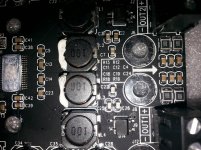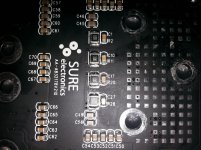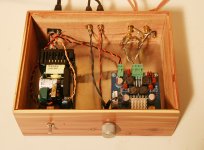Bootstrap Snubbers added to New Hiamp mini 65x65mm and 65x100mm Boards, all improved pop issue under the power on/off conditions.


Coming my new finished TPA amp with Motorized ALPS Pot. + IR remote control. 🙂

TPA with VU Meter ... Much Fun and Visual ... Dynamic Pointer Dancing








The 77watts was achieved with the gen1 DUG amp with Panasonic 560uF 35v caps and a 90w 19.6v laptop power supply. I measured 17.5volts at speaker terminals with sine wave input at 50Hz. I normally listen at typical levels of under 4 volts.
The best supplier for postage here in the UK is RS Online I think, they have most of the parts I need but they only have Murata 220nF ±10% 630 V dc X7R for the bootstrap capacitor (part number RDER72J224K5B1C13B)
They 250V version is sold out, anyone with any experience of these? are they likely to be better than the stock bootstraps that came on my £10 blue YJ board?
stu
They 250V version is sold out, anyone with any experience of these? are they likely to be better than the stock bootstraps that came on my £10 blue YJ board?
stu
The best supplier for postage here in the UK is RS Online I think, they have most of the parts I need but they only have Murata 220nF ±10% 630 V dc X7R for the bootstrap capacitor (part number RDER72J224K5B1C13B)
They 250V version is sold out, anyone with any experience of these? are they likely to be better than the stock bootstraps that came on my £10 blue YJ board?
stu
Buy Ceramic Multilayer Capacitors TDK 220nF 5% 50 V C0G Dielectric SMD Ceramic Multilayer Capacitor 1812 TDK C4532C0G1H224J320KA online from RS for next day delivery.
i have exactly the same psu.
surehifi has lowered the price to € 13.80 incl shipping.
do they clone meanwell or something?
the psu really ok for that price.
Last edited:
TPA with VU Meter ... Much Fun and Visual ... Dynamic Pointer Dancing







So awesome, will you be selling the full assembled unit in your ebay store?
I don't know what impedance options they have for the transformers, but the output towards the amp would be well to be at least as low as the impedance at the gain you have, and up to 10x less. In fact this makes the amp "easier" to drive and acts somewhat like owning a buffer that has minimal loss instead of minimal gain.
Likewise, you want the side towards your volume/source to be high impedance than the volume/source, with the same general principle.
In terms of impedance, is it safe to summarize/simplify as follows:
Source <= transformers <= amp
?
Good going!
Looks great to me. The main thing is you got it going and you are trying. Keep up the good work. Put it in a nice box and enjoy. Mine is just stock. I haven't modified a thing and to me, sounds great!
Mark
Wanted to put the board into a lego box earlier, but when I hooked it up to check if the signal connection is soldered okay, I just couldnt unhook it. Still listening to the thing😀
The topping tp20 was not only too weak for chr70's in a fh3 box, but the sound also lacked some "body". This is THE thing. I don't really see why, but I may try some stingy mods. Someday. If I manage to give it enough off time😛
Here's the photo I'm not proud of..😛
Looks great to me. The main thing is you got it going and you are trying. Keep up the good work. Put it in a nice box and enjoy. Mine is just stock. I haven't modified a thing and to me, sounds great!
Mark
In terms of impedance, is it safe to summarize/simplify as follows:
Source <= transformers <= amp
?
Sorta, the prefered being
Source < (transformer |>| transformer) < amp
Source < volume < (transformer |>| transformer) < amp
But you might not get what you want at volume to transformer depending on volume and source sizing.
Source < volume </=/> (transformer |>| transformer) < amp
Im thinking about replacing some stock caps on the Sure TPA 3116 board. From what you can tell, do these look like the right values and right parts for an upgrade ?
Replace 4 of the snubber caps c1, c10, c17, c27 with the below
Mouser Electronics - Electronic Components Distributor
Replace c7, c22 with the below
Mouser Electronics - Electronic Components Distributor
What do you think?
Replace 4 of the snubber caps c1, c10, c17, c27 with the below
Mouser Electronics - Electronic Components Distributor
Replace c7, c22 with the below
Mouser Electronics - Electronic Components Distributor
What do you think?
Attachments
Last edited:
Prezden,
You are dealing with dangerous voltages here and unless you are used to working with 120vac - what you have is kind of dangerous.
You need an AC receptacle and cord that has ground if you want to ground it. If you were to switch the AC input to a grounded one, connect earth ground on AC (green) to ps ground and negative. The box being made of wood doesn't help the safety as the potential shock of touching the volume knob or power switch are still an issue. This is why I stick with SMPS bricks that handle all the AC internally and I am left with only ground and 19v to worry about. You have an open frame supply but you are treating it like a 19v design.
You are dealing with dangerous voltages here and unless you are used to working with 120vac - what you have is kind of dangerous.
You need an AC receptacle and cord that has ground if you want to ground it. If you were to switch the AC input to a grounded one, connect earth ground on AC (green) to ps ground and negative. The box being made of wood doesn't help the safety as the potential shock of touching the volume knob or power switch are still an issue. This is why I stick with SMPS bricks that handle all the AC internally and I am left with only ground and 19v to worry about. You have an open frame supply but you are treating it like a 19v design.
3 prong outlet...make a star ground with a terminal block or post or something and ground the boards and pot to the star ground.
Sorta, the prefered being
Source < (transformer |>| transformer) < amp
Source < volume < (transformer |>| transformer) < amp
But you might not get what you want at volume to transformer depending on volume and source sizing.
Source < volume </=/> (transformer |>| transformer) < amp
I have not tried the Edcor 1:1 input transformers, so I cannot comment on the sound quality. I can say that in using the CineMag CMLI-15/15B input transformers, the switch from using single-ended inputs to differential (i.e., balanced) inputs was night and day. Not only was there no signal loss, but the sound quality was instantly improved in terms of a significantly lower noise floor, tonality, detail, and a noticeable increase in soundstage scale and depth. This seems to fail in line with others' observations using Sowter and Lundahl transformers. In fact, I'm listening to The Beatles' "Sgt. Pepper's Lonely Hearts Club Band" new mono vinyl reissue remastered from the original analog masters, and it actually sounds much better than the Mobile Fidelity stereo remaster. To hear "A Day in the Life" like this is really amazing.
I have to ask the question if one were to use pro studio mixing equipment with balanced line outs, and if one were to connect this to a TPA3116 with balanced mode inputs but with caps - would the sound quality be significantly improved due to the inherent common mode noise rejection built into balanced inputs? So is it really the transformer and lack of caps or is it just using the balanced input config that is making all the difference?
And an additional question: if you put a volt meter across the outputs of your source/pre, and find there is no DC, wouldn't a wire be better than any cap or xformer?I have to ask the question if one were to use pro studio mixing equipment with balanced line outs, and if one were to connect this to a TPA3116 with balanced mode inputs but with caps - would the sound quality be significantly improved due to the inherent common mode noise rejection built into balanced inputs? So is it really the transformer and lack of caps or is it just using the balanced input config that is making all the difference?
And as a final test, before connecting speakers, put the volt meter across the amp's outputs to confirm there is no DC.
I'm guessing most source components - at least off the shelf stuff - has caps across the outputs. If true, then additional DC blocking at the amp is redundant. Maybe?
- Home
- Amplifiers
- Class D
- TPA3116D2 Amp




